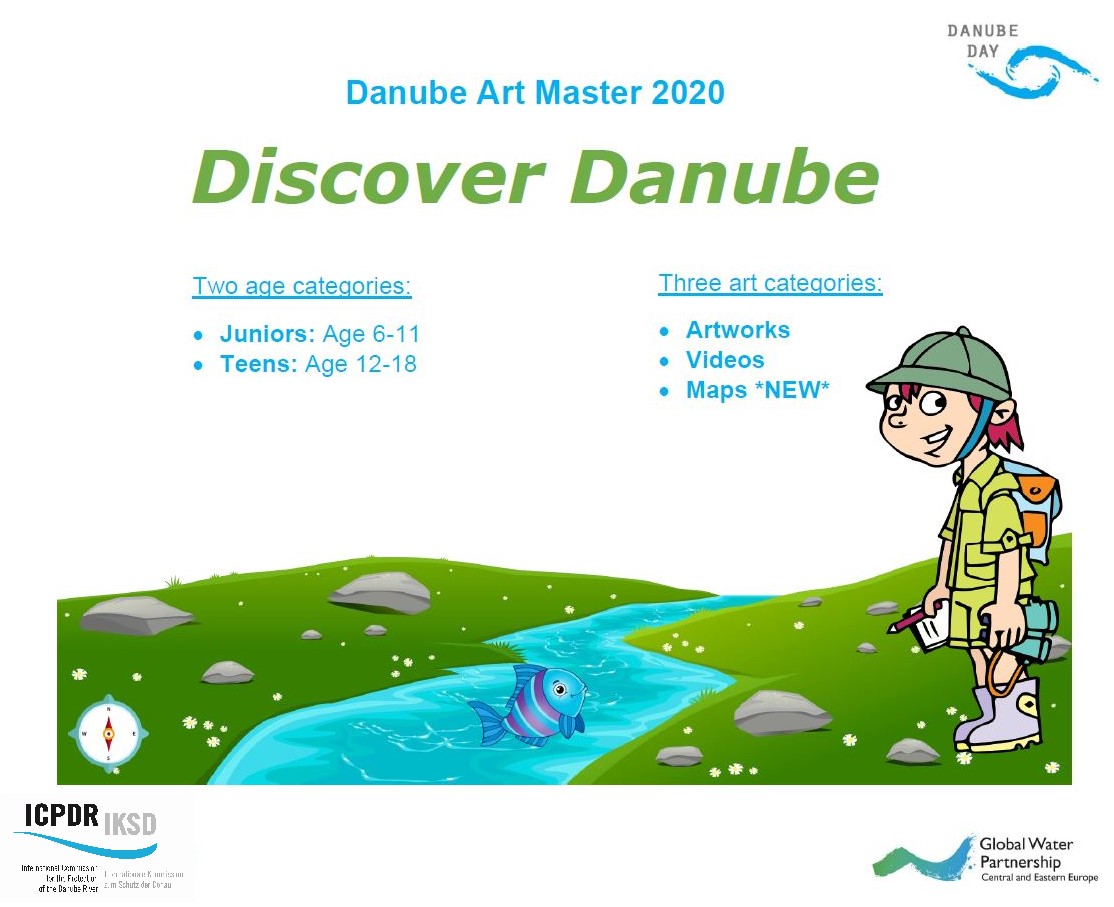Jointly organized by the Global Water Partnership Central and Eastern Europe (GWP CEE) and the International Commission for the Protection of the Danube River (ICPDR), this competition encourages children to have a closer look at their local river, to reflect on what the environment means to them, and to create original artworks to celebrate the region.
Youth from all schools, NGOs, clubs, daycare centers or associations for children in the Danube Basin are invited to create a piece of art and take part in the Danube Art Master competition, which has been uniting thousands of young people throughout the Danube River Basin since 2004. The competition doesn’t only bring children of the Danube region together, but also educates them about the river’s intrinsic value and importance as well as gives them a voice to reflect on the future of their environment.
COMPETITION DETAILS
Participants must be from a country in the Danube Basin (Germany, Austria, Czech Republic, Slovakia, Hungary, Slovenia, Croatia, Bosnia and Herzegovina, Serbia, Montenegro, Romania, Bulgaria, Moldova, Ukraine).
Participants are divided based on their age at the time of submitting the entries:
- Juniors: Age 6-11
- Teens: Age 12-18
Participants can join as individuals, as a class, or as a group of max. 4 people.
The competition will run at two levels: national and international. Once selected at the national level, national winners will then compete at the international level. The competition will take place between 1 September - 30 October. The participants are encouraged to check the submission deadline with their national organizer.
Children should go to a riverbank (ideally Danube river or a Danube tributary) and create their environmental art.
As this year the motto is “Discover Danube”, we introduce a new category – Map. Participants can explore the riverbank and create a map that can mark various points of interest (e.g. castle), significant places highlighting biodiversity, places for recreation (beaches, parks, bike lanes, etc.), and also places that might need more attention (e.g., places in a bad condition, places that require a clean-up, flooded zones, etc.). The map can also reveal some curious or less known facts about the river.
After creating their artwork, children or teachers should take a color photo or video of the artwork and send it to the national organizer. It is necessary to be sure that files are in high resolution, not crooked, ready for printing, and can be easily viewed.
CATEGORY SPECIFICATIONS
• Artworks - should be created with natural materials found by the river. E.g. sculpture, collage, fashion & jewelry, etc. Drawings and paintings are NOT accepted. The minimum size of digital photos is 150 DPI and 3 megabytes.
• Videos - should not be longer than 1 minute. They can be recorded by camera or phone. Animations will not be accepted. Students could make a film, play a song or perform.
• Maps - should be created on an A3 format page. The map should include compass directions, distance or scale, a legend, symbols to represent different objects. Students are encouraged to unleash their creativity and present any interesting facts and spots on the map. High-resolution photos or scans of the map should be sent to the national organizers. The minimum size of the files is 150 DPI and 3 megabytes.
WINNER SELECTION
National level
At the national level, the national organizers will judge different forms of art. National prizes vary from country to country, and participants are encouraged to contact their country’s organizer for details. The top 10 national artworks will be posted on the official DAM Instagram account.
International level
At the international level, one national winner in Juniors and one in Teens, in all three categories, will be judged by an international jury, comprising of the national representatives of all ICPDR countries. For the judging, text or other hints of the national artwork’s nation of origin will be redacted to facilitate neutral assessment. The judges’ decision is final, and the creator(s) of the chosen artwork will be crowned ‘Danube Art Master’.
After the competition, an exhibition will be organized with the photos of the best artworks from each country connected with an international event organized by the ICPDR.
Employees and officers of GWP CEE and ICPDR, as well as the immediate family (defined as parents, spouses, children, siblings and grandparents) are not eligible to take part in the competition.
The story behind the artwork (required only at international level):
All submissions on international level must include a written story in English (artist’s statement) of up to 250 words. The story can describe: 1) the creative process and 2) what the participant has learned through the river-basin exploration.
Here are some guiding questions for the reflection:
What is your message to the audience?
What inspired your work?
While creating your artwork, what have you learned?
Participation in the competition constitutes the winner’s consent for their name and contribution picture to be made public in publications of GWP CEE and the ICPDR. GWP CEE and ICPDR reserves the right to use the photographs/videos taken without the expressed written permission of those included within the photographs/videos.
Social media
Apart from the main competition, the Top 10 works from all countries will participate in an online competition. There will be a special prize for the Most Liked Art on Danube Art Master’s Facebook page. Only the artworks submitted officially by the national organizers can compete for the most liked prize.
For more information, see www.danubeday.org
Alternatively, you can contact Veronika Vagoova at veronika.vagoova@gwpcee.org
